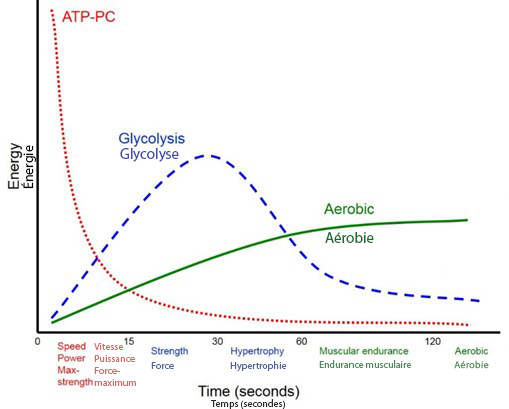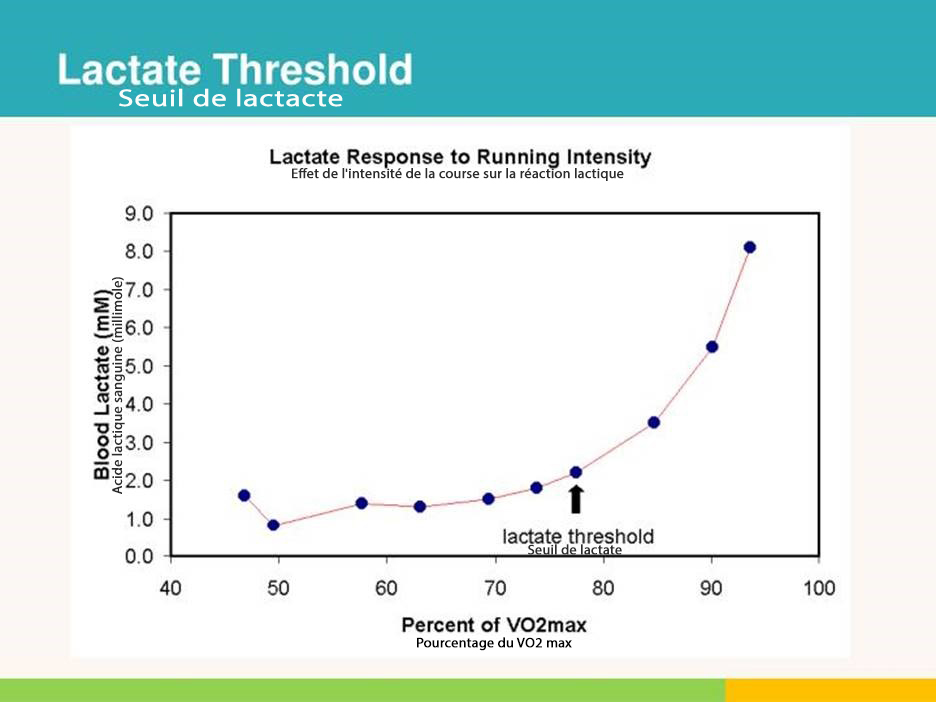Track and field for Masters Athletes 6: Understanding energy systems
Related Links
- Athletics Canada – Masters Athletics
- Track and field for Masters Athletes 5: Planning your training phases
- Track and field for Masters Athletes 4: Planning Basics
- Track and field for Masters Athletes 3: Physical assessment
- Track and field for Masters Athletes 2
- Track and Field for Masters Athletes 1
News Article / October 16, 2020
Click on the photo under “Image Gallery” to see more photos.
This is the sixth in a series of articles covering all aspects of Masters Athletes’ training and nutrition for track and field events. Here, we take a good look at how your body produces the required energy in order to do the work for your discipline.
By Major Serge Faucher
In a previous article, we explored the benefits of periodization and high-level planning for your training program. We then took a closer look at the phases of training, and how they are laid out over a specific period. Before we dive into building the desired microcycles (your weekly schedule), which would incorporate the appropriate training and recovery sessions, we have to take a good look at how your body produces the required energy in order to do the work for your discipline. This is important because it will clarify the reasons why you include certain workouts in your particular training program. Once you understand this, you can specifically tailor a training program that will suit your goals. We could go down the rabbit hole because this is a very complex subject, but I’ll try to keep it simple, and stick to the basics when it comes to energy production and needs for athletes.
We use energy from food to fuel movement and essential body functions. Once food is digested, the carbohydrates, protein, and fat break down into simple compounds: glucose, amino acids and fatty acids, which are absorbed into the blood and transported to various cells throughout the body. Within these cells, and from these energy sources, adenosine triphosphate (ATP) is formed to provide fuel. The body uses 3 different systems to supply cells with the necessary ATP to fuel energy needs. They are the creatine phosphate (ATP-PC), the anaerobic lactate (Glycolysis), and the aerobic systems. Most of the body's activities use a continuum of all three energy systems working together to ensure a constant supply of energy. Therefore, the vast majority of athletes must train all three systems because all are used in running.
As seen in Figure 1, these energy systems do not work independently and do not function in isolation. Rather, all systems operate at all times. However, some may predominate based on the body's activities, including the type, intensity and duration of physical activity as well as a person's fitness level.
Here is a quick table explaining some of the terminology used in associating an energy source to the duration and intensity of the effort exerted by the athlete.
| Duration of Work | Classification | Energy Source |
|---|---|---|
| 1 to 4 seconds | Anaerobic, Alactic | ATP |
| 4 to 10 seconds | Anaerobic, Alactic | ATP + PC |
| 10 to 45 seconds | Anaerobic, Alactic | ATP + PC + Muscle Glycogen |
| 45 to 120 seconds | Anaerobic, Lactic | Muscle Glycogen |
| 2 to 4 minutes | Anaerobic + Aerobic | Muscle Glycogen + Lactic Acid |
| 4 to 10 minutes | Aerobic | Muscle Glycogen + Fatty Acid |
Table 1 - Relationship between exercise intensity and the energy source used to sustain it
For short and intense movement lasting less than 10 seconds, the body mainly uses ATP-PC. Your body needs a continuous supply of ATP for energy, whether it’s needed for lifting weights, walking, thinking or running. It is important in the 100m and 200m events, and also in the final sprint at the end of a middle-distance race. This system is, in fact, anaerobic, which means it does not use oxygen. It utilizes the relatively small amount of ATP stored in muscles for this immediate energy source. When the body's supply of ATP is depleted, which occurs in a matter of seconds, additional ATP is formed from the breakdown of phosphocreatine (PC), an energy compound found in muscles. Running fast repeats under 20 seconds results in little lactic acid buildup, hence less fatigue.
The length of recovery between repetitions is important in the recovery of power output through the resynthesis of creatine phosphate. Studies have shown an 80% recovery in peak power output with a 1-minute recovery, and a 92% recovery after 3 minutes. Once we have depleted our ATP (through a 1-rep max squat attempt, for example), it takes at least 3 minutes of rest for muscles to recover the maximum amount possible of ATP and creatine phosphate. Following those 3 minutes, your ATP-PC system will be ready for explosive movements again. Therefore, it’s quite obvious that if you attempt to lift or sprint again within these 3 minutes, you will struggle to get the same results. To develop this energy system, sessions of 3 to 10 seconds of high-intensity work at near peak velocity are required. For example:
- 10 X 30m with 3 minutes recovery;
- 6 X 60m with 6 minutes recovery; or
- Lifting the heaviest weight you possibly can for 1 or 2 repetitions.
In my case, I keep things simple whenever I run short sprints. For every 10m of all-out effort, I take 1 minute of rest. My Anaerobic Alactic (ATP-PC) sprint sessions will start with 30m sessions throughout the beginning of track season (Phase I) and the introduction of speed in Phase II. As a 400m athlete, I normally don’t run anything under this distance. As the weeks go by, I’ll increase the distance by 10m a week until I reach 80m (8 min rest).
Beyond 80m, your body will start using a combination of ATP + CP + Muscle Glycogen, which includes the use of glycogen as an energy source. These are done in Phase III when my body has been accustomed to handle sprint training over several months. One example of this workout would be:
- Two sets of 120m, 100m, 80m, and 60m done at over 95% intensity with a very slow walk back recovery. Do not attempt this while in Phase I or II as it is very intense and may lead to injury.
The lactic acid system is the most predominant energy system for event lasting 10 second to a few minutes. In fact, this pathway will still be contributing energy in a marathon, but at a much slower rate. It produces energy from muscle glycogen (the storage form of glucose). Glycolysis can occur in the presence or absence of oxygen. When inadequate oxygen is available, the series of reactions that transforms glucose into ATP causes the ever-dreadful lactic acid to be produced in efforts to make more ATP. The accumulation of lactic acid can cause fatigue and a burning sensation in the muscles, which all Canadian Armed Forces members have experienced during the Intermittent Loaded Shuttle of the Force Test. This accumulation of lactic acid is also the limiting factor causing fatigue in runs of 300m to 800m in general.
This is one of the most important energy systems you must train if you are to play ball hockey, basketball, or soccer (stop-and-go activities). When exercising at or below the lactate threshold, any lactate produced by the muscles is removed by the body without it building up. Lactate threshold is defined as the intensity at which the blood concentration of lactic acid begins to increase exponentially. It is often expressed as 85% of maximum heart rate or 75% of maximum oxygen consumption. Most of us going for an easy run will not cross this line as we remain in the aerobic zone. Since the 400m athlete will spend close to 50% of all his or her time training the glycolytic system, it’s important to take a look at how to improve this energy system. Running several 400m repeats with a very short rest will get you there in a hurry!
So how do you improve your lactate threshold? In doing so, you may find that your muscles can't last as long because they're producing lactic acid very rapidly compared to running at a slower and steady pace. Therefore, in order to run faster without the early onset of lactic acid, you need to train at a faster speed for longer duration, and continue to do so until your aerobic and anaerobic endurance improve to a point whereby your body becomes more efficient at producing the needed energy.
In secondary school, my brother Claude ran the 1500m (4:08 min), the 3000m (8:54 min), and the 5000m (15:29 min). Following his enrollment in the CAF, he ran for the CF National team for many years, focusing on road racing and CISM cross country. These longer distances were not conducive in improving his track times. No matter how often he tried, he just could not crack the 4-minute mark in the 1500m. As you would expect, this race distance is brutal when it comes to lactic acid production.
After joining his new track club circa 1989 while posted to Baden-Baden, Germany, his new coach urged him to change some of his workouts by reducing the volume by half, and increasing the speed of the intervals. He went from doing sessions of 20 X 200m in 30 seconds to doing 8 X 200m in 26 seconds. His coach would say, “If you want to run fast, you must train fast”. While he did not break the elusive 4-min mark on 1500m, he nonetheless had great performances in the 1000m, covering the distance in 2:29.76 min, and the 3000m in 8:43 min. These are some of the best races he’s ever done.
It was not until he made it back to Canada in 1992 that he finally broke the 4-minute barrier. He accomplished this by training with some of the fastest runners in Canada; individuals who ran the 800m in 1:50 min. Training with them forced him to run many 800m-style training sessions. The speed gained from those sessions was invaluable. Claude ran his best 800m (1:55 min) and 1500m (3:54 min) during that period.
If you train slowly, your anaerobic threshold will be lower than if you train at faster speeds. Your body adapts to how it is trained. Here are a few session examples to develop this energy system:
- 10 X 300m intervals – 1 minute recovery;
- 8 X 400m intervals – 2 minutes recovery; or
- 6 X 600m intervals – 3 minutes recovery.
The aerobic energy system provides the foundation for all activity you may undertake, and most of the body's ATP production. The energy released comes from the breakdown of nutrients such as glucose, lactate, and fatty acids. In the presence of oxygen, ATP can be formed through glycolysis. This system also involves the Krebs cycle and the Electron Transport Chain, which is a series of chemical reactions that generate energy in the mitochondria; the power plant inside the body cells.
The aerobic energy system is the most complex of the three energy systems, and relies heavily on our circulatory system to supply oxygen. This makes it slower to act compared to the other two systems mentioned earlier, and most active at a very low intensity. The rate of production of energy is very slow (it relies on oxygen you consume and utilize with each breath), though it can continually produce a large amount of energy over time. This energy system supplies energy for body movement lasting more than just a few minutes, such as long periods of work or endurance activities. For most distances over 400m, you must prioritize this system above all others based on its importance. It is, in fact, the foundation to any training program, including sprinting.
This system also serves to recover other energy systems during times of low intensity (rest periods between intervals). Your ability to recover in the down-time between intervals of high intensity work is due to your aerobic system. Most short (100m/200m) sprinters don’t have a good aerobic development. They tend to get “winded” pretty quickly, and many forget that this is the energy system that will keep you performing at your best during a long track meet that may last a week or longer; where you race twice each day, including two to three rounds of 100m, two to three rounds in the 200m, and more of the same for the 400m, along with the relays on the last day of the meet. Only a very aerobically-fit sprinter will survive this grueling schedule, and perform every time.
Continuous exercise at an intensity just below your lactate threshold, or roughly 70%-75% maximum heart rate, is a great way to train this system. As explained earlier, your lactate threshold is the point at which your body’s demand for oxygen is greater than the supply. This causes an accumulation of lactate in the muscle, which most people equate to the burn you feel when performing intense exercise.
You could start with 20 minutes of work, and gradually build over time up to 60 minutes. Once you can perform 60 minutes at the same intensity, you should amp up the intensity slightly as your anaerobic threshold is raised, or begin mixing in extended intervals with minimal rest. Longer intervals lasting more than 2 minutes with minimal rest between, at or just below your lactate threshold is a great way to train your aerobic system and to improve the efficiency that your muscles can use oxygen to produce energy. Personally, I enjoy using the Concept 2 rower on my “off days” to train the aerobic system and enhance recovery. It’s a whole-body exercise that is easy on the joints. You could also use the AirDyne, cross-country ski, swim, or ride a bike if you prefer. Here are a few session examples to develop this energy system:
- 60 min jog;
- 5 X 1000m with 5 min rest ; or
- 2 X 2400m with 8 min rest.
To sum up what was covered in this article, your training program must develop all the energy pathways, muscular system and technique if you want to be the best you can be in your discipline. Here are examples of different training sessions and their objectives:
| Session | Objective |
|---|---|
| 30- to 60-minute easy running | Aerobic Capacity |
| 20-minute run just above a steady pace | Aerobic Power |
| 3- to 10-minute repetition runs 1 to 3 minutes of recovery |
Aerobic Power & Lactic Capacity |
| 1- to 2-minute repetition runs 2 to 4 minutes of recovery |
Aerobic Power & Lactic Capacity |
| 45- to 90-second repetition runs 10 to 15 minutes of recovery |
Lactic Capacity & Lactic Power |
| 30- to 45-second repetition runs 10 to 15 minutes of recovery |
Lactic Power |
| 30- to 45-second repetition runs reducing of recover | Lactic Capacity |
| 15- to 30-second repetition runs 10 to 15 minutes of recovery |
Alactic Capacity |
| 6- to 15-second repetition runs 1 to 3 minutes of recovery |
Alactic Power |
| Weight training - 1 to 3 RM | Muscular Strength |
| Weight training - 12 to 20 RM | Muscular Power |
| Circuit Training | Muscular Endurance |
| Hill runs of 5 to 10 seconds | Alactic Power & Muscular Endurance |
| Hill runs of 15 to 30 seconds | Lactic Lower & Muscular Endurance |
| Hill runs of 30 to 60 seconds | Lactic Capacity & Muscular Endurance |
| Technique | Economy and Effectiveness of Effort |
| Rest | Allows adaptation |
Now that you’ve been exposed to the basics of energy systems, you are ready to understand the elements that comprise most training programs out there. In the next article, I will focus on the 400m training program I use as the basis for my personalized training. It is a canvas to work from, having all the proper distribution of exercises and energy systems needed to succeed in that particular distance. This will serve as a good example to follow when you to build your own program.




